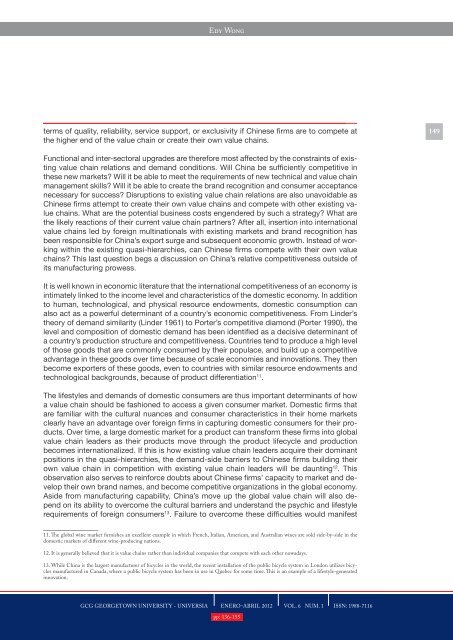Vol. 6 Num. 1 - GCG: Revista de Globalización, Competitividad y ...
Vol. 6 Num. 1 - GCG: Revista de Globalización, Competitividad y ...
Vol. 6 Num. 1 - GCG: Revista de Globalización, Competitividad y ...
Create successful ePaper yourself
Turn your PDF publications into a flip-book with our unique Google optimized e-Paper software.
Edy Wongterms of quality, reliability, service support, or exclusivity if Chinese firms are to compete atthe higher end of the value chain or create their own value chains.149Functional and inter-sectoral upgra<strong>de</strong>s are therefore most affected by the constraints of existingvalue chain relations and <strong>de</strong>mand conditions. Will China be sufficiently competitive inthese new markets? Will it be able to meet the requirements of new technical and value chainmanagement skills? Will it be able to create the brand recognition and consumer acceptancenecessary for success? Disruptions to existing value chain relations are also unavoidable asChinese firms attempt to create their own value chains and compete with other existing valuechains. What are the potential business costs engen<strong>de</strong>red by such a strategy? What arethe likely reactions of their current value chain partners? After all, insertion into internationalvalue chains led by foreign multinationals with existing markets and brand recognition hasbeen responsible for China’s export surge and subsequent economic growth. Instead of workingwithin the existing quasi-hierarchies, can Chinese firms compete with their own valuechains? This last question begs a discussion on China’s relative competitiveness outsi<strong>de</strong> ofits manufacturing prowess.It is well known in economic literature that the international competitiveness of an economy isintimately linked to the income level and characteristics of the domestic economy. In additionto human, technological, and physical resource endowments, domestic consumption canalso act as a powerful <strong>de</strong>terminant of a country’s economic competitiveness. From Lin<strong>de</strong>r’stheory of <strong>de</strong>mand similarity (Lin<strong>de</strong>r 1961) to Porter’s competitive diamond (Porter 1990), thelevel and composition of domestic <strong>de</strong>mand has been i<strong>de</strong>ntified as a <strong>de</strong>cisive <strong>de</strong>terminant ofa country’s production structure and competitiveness. Countries tend to produce a high levelof those goods that are commonly consumed by their populace, and build up a competitiveadvantage in these goods over time because of scale economies and innovations. They thenbecome exporters of these goods, even to countries with similar resource endowments andtechnological backgrounds, because of product differentiation 11 .The lifestyles and <strong>de</strong>mands of domestic consumers are thus important <strong>de</strong>terminants of howa value chain should be fashioned to access a given consumer market. Domestic firms thatare familiar with the cultural nuances and consumer characteristics in their home marketsclearly have an advantage over foreign firms in capturing domestic consumers for their products.Over time, a large domestic market for a product can transform these firms into globalvalue chain lea<strong>de</strong>rs as their products move through the product lifecycle and productionbecomes internationalized. If this is how existing value chain lea<strong>de</strong>rs acquire their dominantpositions in the quasi-hierarchies, the <strong>de</strong>mand-si<strong>de</strong> barriers to Chinese firms building theirown value chain in competition with existing value chain lea<strong>de</strong>rs will be daunting 12 . Thisobservation also serves to reinforce doubts about Chinese firms’ capacity to market and <strong>de</strong>veloptheir own brand names, and become competitive organizations in the global economy.Asi<strong>de</strong> from manufacturing capability, China’s move up the global value chain will also <strong>de</strong>pendon its ability to overcome the cultural barriers and un<strong>de</strong>rstand the psychic and lifestylerequirements of foreign consumers 13 . Failure to overcome these difficulties would manifest11. The global wine market furnishes an excellent example in which French, Italian, American, and Australian wines are sold si<strong>de</strong>-by-si<strong>de</strong> in thedomestic markets of different wine-producing nations.12. It is generally believed that it is value chains rather than individual companies that compete with each other nowadays.13. While China is the largest manufacturer of bicycles in the world, the recent installation of the public bicycle system in London utilizes bicyclesmanufactured in Canada, where a public bicycle system has been in use in Quebec for some time. This is an example of a lifestyle-generatedinnovation.<strong>GCG</strong> GEORGETOWN UNIVERSITY - UNIVERSIA ENERO-ABRIL 2012 VOL. 6 NUM. 1 ISSN: 1988-7116pp: 136-155















